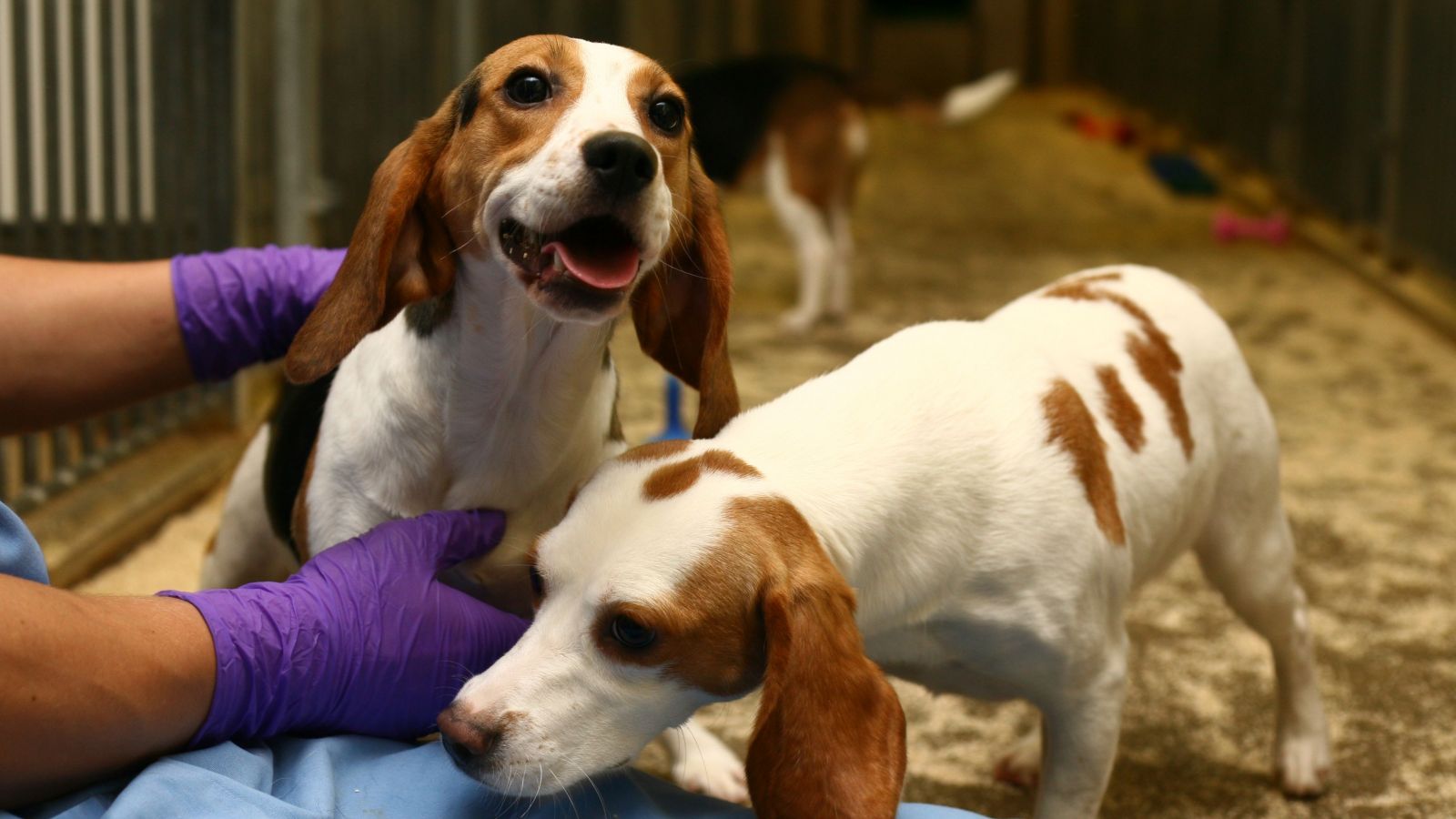Read our Dog Testing FAQ
Our new Dog FAQ page provides answers to the most frequently asked questions about dogs in research.
Dogs (Canis familiaris) belong to the family Canidae and are thought to be one of the first domesticated animals. They have been used in research for more than a century, however, they are currently very rarely used in animal research in Great Britain, only being used in 0.24% of experimental procedures in 2019 (latest published figures).
They are medium-sized mammals that can grow from 15 to 100 cm and weigh from 1.5 to 75 kg, depending on the type of dog. Dogs are carnivores but can thrive on a well-designed suitably processed omnivorous diet in the domestic situation.
Why are dogs used in research?
In the UK, dogs are primarily used to find out how new drugs act within a whole, living body and whether new medicines are safe enough to test in humans. They predict this safety very well, with up to 96% accuracy.
This is done to satisfy safety regulations which came about after the drug Thalidomide maimed and killed children while they were still in the womb. It is known as toxicology testing, but normally seeks to confirm the absence of toxic effects.
The tests can tell us lots of sorts of information all at once, like the safety if a drug across lots of different internal organs, how the drug travels around the body and other information that helps us to design much safer human trials.
Dogs are also used to test the safety and efficacy of veterinary medicines, and also in nutrition studies to ensure that pet dogs eat healthily, particularly when they are prescribed specialist diets by their vets.
Although animal and nonanimal methods are used alongside each other, there are currently no alternatives to using dogs. They nevertheless have special protections under UK law. For instance, they cannot be used if another animal species could be used.
There is a project that hopes to create a ‘virtual dog’ that could significantly reduce the number of dogs needed by using computers to mine historical dog data. It is being run by the UK’s national centre for developing animal replacements, the NC3Rs, but is of international interest.
What types of research are dogs used in?
The physiological similarities between humans and dogs mean that they are useful in various types of research. Their genome has been sequenced and because of our genetic similarities, they are often used in genetic studies.
Dogs are primarily used in regulatory research, also known as toxicology or safety testing. This type of research is required by law to test the safety and effectiveness of potential new medicines and medical devices before they are given to human volunteers during clinical trials. Dogs are also used to test the safety and efficacy of veterinary medicines, and also in nutrition studies to ensure that pet dogs eat healthily, particularly when they are prescribed specialist diets by their vets.
A smaller number of dogs are also used in translational research (also called applied research) to help us learn about human and animal diseases so that we can develop treatments. Examples of translational diseases can be found below.
Dogs are also used to study Duchenne muscular dystrophy (DMD), which is the most common type of muscular dystrophy. It is another condition that can affect both humans and dogs. Because dogs can naturally have this condition, they can be studied to show how the condition progresses. This very useful model for DMD has helped scientists work on better genetic tests and treatments for the condition.
An early use of dogs in research was in the search for a treatment for diabetes, which resulted in the discovery of insulin. This discovery in the 1920s, which won researchers a Nobel prize, now allows people with diabetes to live long lives. In the past, people with diabetes would die soon after developing the condition.
How are the dogs looked after?
The use of animals in research is highly regulated, an important part of that regulation is ensuring the animals are housed and cared for correctly. Laboratory dogs are housed in enclosures that can isolate individual dogs for treatment but usually opened up for dogs to interact. Dogs’ need to socialise is well considered, so the dogs are housed in small groups most of the time. The facilities usually also have space to run around for exercise and you can usually find dogs interacting with each other, environmental enrichments, and the animal technicians.
https://www.nc3rs.org.uk/3rs-resources/housing-and-husbandry/housing-and-husbandry-dogs
You can see this in this film about dogs in research.
References
https://www.nationalgeographic.com/animals/mammals/d/domestic-dog/
https://www.britannica.com/animal/dog/Breed-specific-behaviour#ref15478
http://www.animalresearch.info/en/designing-research/research-animals/dog/
Dogs in drug safety prediction: https://pubmed.ncbi.nlm.nih.gov/28893587/
Virtual dog: https://nc3rs.org.uk/news/ps16m-awarded-develop-virtual-second-species




